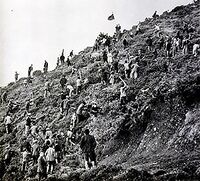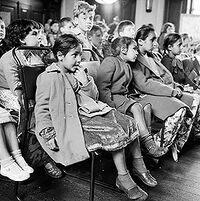Golden Revolution: Difference between revisions
mNo edit summary |
mNo edit summary |
||
| Line 24: | Line 24: | ||
[[Esua Nadel]] and [[Denise Sarrault]], Gylias' most widely-read {{wpl|columnist}}s, also played a role in public acceptance of the Golden Revolution: their tone of sympathy tinged with bemusement, sharply observant humour, and coverage of Gylias' [[Political culture of Gylias|colourful political culture]] and public life helped instil pride in those traits among readers. | [[Esua Nadel]] and [[Denise Sarrault]], Gylias' most widely-read {{wpl|columnist}}s, also played a role in public acceptance of the Golden Revolution: their tone of sympathy tinged with bemusement, sharply observant humour, and coverage of Gylias' [[Political culture of Gylias|colourful political culture]] and public life helped instil pride in those traits among readers. | ||
[[President of | [[President of Gylias|President]] [[Reda Kazan]] established herself as a powerful voice promoting a reunion of radicalism and restraint, and "beautification" of public life — making her a close friend and kindred spirit of [[Saorlaith Ní Curnín]], [[Ðaina Levysti]], [[Marguerite Tailler]], [[Neelie op het Mensink]], and [[Penelope Morris]], among others. | ||
==Goals== | ==Goals== | ||
Revision as of 07:04, 5 July 2022

Part of a series on the |
|---|
| History of Gylias |
 |
The Golden Revolution (French reformed: Révolution doré) was a period of intense and far-reaching political, economic, social, and cultural change in Gylias, lasting roughly from 1958 to 1976.
The movement was rooted in the radical milieu of the Gylian ascendancy and Alscia, and built on the breakthroughs of the Free Territories. It was fundamentally influenced by anarchism, and took place through mass participation, with encouragement and guidance by the Darnan Cyras government.
The Golden Revolution affected every facet of Gylian life — from transformation of the economy to the creation of social security, from demopolitan reimagining of cities to emergence of a thriving pop culture, and from consolidation of direct democracy through communal assemblies to the radical reordering of Gylian politics.
The Golden Revoution's energy gradually ebbed away during the 1970s; conventionally, its ending is placed in 1976, when that year's federal election began the wretched decade. While falling short of its ultimate goal of making Gylias an anarchist society, the Golden Revolution was responsible for Gylias' profound transformation into a modern, democratic polity with a distinctive socioeconomic model and flourishing culture. Its key achievements have been consolidated into the Gylian consensus, and it has identified Gylias strongly with idealism, hedonism, and artistry within Tyran.
Background
Gylians' long struggle against Xevdenite oppression contributed to a close connection between the Gylian ascendancy and political radicalism. The existence of Alscia in the early 20th century strengthened the connection, as it played a key role in disseminating and popularising radical ideas. By the time the Liberation War erupted, the majority of the populace was primed and receptive to radical ideologies like anarchism, communism, and socialism.
The Free Territories were proclaimed during the war, and became a successful autonomous anarchist zone, ultimately uniting both the Gylian opposition under their umbrella and winning the Liberation War. The length of the war paradoxically turned out advantageous, producing new generations of Gylians with lived experience of anarchist organisation and self-governance. Much of the Golden Revolution would be an extension of the Free Territories' model throughout Gylias, with a climate of revolutionary utopianism now matched to peace and prosperity rather than war.
Grassroots and leadership
A dominant factor in the success of the Golden Revolution was its mass movement nature and diversity of prominent figures. Darnan Cyras was atypical among Tyranian revolutionaries: he lacked charisma, had a lukewarm image and a laconic speaking style. On becoming Prime Minister of Gylias, he deliberately sought to keep a low profile and assume a "secondary role" within the government, being a strong opponent of a cult of personality.
With Darnan rejecting the role of a central figure, the collective nature of his cabinet allowed multiple charismatic and influential figures to share the spotlight, including the Tōsaka family, Aliska Géza, Eoni Nalion, Erika Ďileş, Clarissa Rossetti, Justina Mendonça Ferreira, Julie Legrand, Eðe Saima, and Birgit Eckstein.
Equally influential in shaping the revolution's course were numerous intellectuals, artists, and activists outside the government, including political theorists and commentators, demopolitan urbanists, scientists, public intellectuals from the Revolutionary Communications Office, philosophers like Margot Fontaine, the ferroses, cultural theorists like Saorlaith Ní Curnín, bohemian art patrons like the Tessai and Mişeyáqueens, models like Isabel Longstowe and Jenny Ford, and civic organisations like OMFLG–ACFEN, GSRAG, and PrF.
Esua Nadel and Denise Sarrault, Gylias' most widely-read columnists, also played a role in public acceptance of the Golden Revolution: their tone of sympathy tinged with bemusement, sharply observant humour, and coverage of Gylias' colourful political culture and public life helped instil pride in those traits among readers.
President Reda Kazan established herself as a powerful voice promoting a reunion of radicalism and restraint, and "beautification" of public life — making her a close friend and kindred spirit of Saorlaith Ní Curnín, Ðaina Levysti, Marguerite Tailler, Neelie op het Mensink, and Penelope Morris, among others.
Goals
The Liberation War consolidated the momentum for change behind anarchists. They were able to create a united front due to their overriding goals of destroying Xevden and creation of a fairer society being shared by forces across the political spectrum, including Donatellist liberals and "constructive" conservatives. Beyond that, their ideology had the advantage of flexibility and accommodating, even encouraging, experimentation with different methods of economic and social organisation as long as they did not impose authority.
The Free Territories' General Declaration of 12 March 1938, which proclaimed freedom, abolition of private property, and self-governance through local councils, served a platformist role as the minimum principles that various anarchist schools of thought could agree upon. Anarchists' strong hostility to statist communists made them willing to collaborate with more moderate leftists, liberals, and conservatives to marginalise authoritarians, culminating in the Lucian Purge of 1956.
Prominent anarchists in the Free Territories saw overly specific goals as dangerous, which risked becoming dogma and inspiring putschism in their implementation. Long resistant to formulating broad goals, Darnan ultimately offered les quatrations ("the four -ations"): "democratisation, liberalisation, socialisation, and modernisation". These conveyed the fundamental aims of abolishing capitalism, ending social repression, implementing self-governance, and "catching up to the civilised world" after centuries of Xevdenite misrule.
The strong anarchist influence resulting from the Liberation War automatically implied a rejection of state-driven models like Ruvelkan Socialist Republic. Gylians would instead look to an eclectic choice of models, including the Ruvelkan Free Territories, the confederal Megelan of the post-Warlord Era, and even the social liberalism and state-led economic planning of Cacerta, Kirisaki, and Akashi.
While abolition of the state remained as an ultimate goal of the Golden Revolution, the second phase of the Liberation War had seen strong objections from liberals, conservatives, and moderate leftists that it remained necessary to remedy Xevden's legacy of poverty and under-development. Darnan and close allies such as the ferroses and Freeman sisters tried to forge a compromise by moving to a withering away of the state position, which caused controversy. Anarchist critics derided the result as a halfway house — Ţaisa Eşal famously quipped, "The tactic of shrinking the state to the level where it can be taken out back and shot demands trust in future generations' ability to provide the firing squad."
Economic reforms

After the Liberation War, the decentralised, anarchist models of the Free Territories were implemented throughout Gylias. A profound reorganisation took place economically. Its key tenets included socialisation of the private sector through cooperatives, nationalisation of key sectors of the economy, promotion of workers' self-management and decentralised planning, and establishing the National Prices Board to set prices, producing a Lange model market socialist economy.
The coexistence of multiple economic models and widespread voluntary exchanges was preserved by making the Gylian þaler a common unit of reference for numerous complementary currencies and non-monetary systems. The flexibility of "emancipated markets" led to the emergence of widespread community markets and merchants as a well-established profession. Calculation in kind and gift economy traits remained common, particularly in dedicated anarchist communities.
The transition from the Free Territories to Gylias coincided with the National Obligation period, which saw nationwide rationing and reconstruction. Rationing accomplished its goal of preserving living standards and guaranteeing adequate food, clothing, and shelter; it was broadly accepted by Gylians. On the other hand, the government feared coming to be associated with deprivation, and thus it was abolished in 1961. However, resource minister Neelie op het Mensink maintained sufficient powers and regulation to keep an unofficial system in place that guaranteed universal basic rations, and helped reduce waste.
Greatly aiding the planning process was the successful implementation of the Hermes Programme, which harnessed cybernetics to achieve coordination nationwide. Similarly beneficial was Gylias joining the Common Sphere in 1958, which provided valuable expertise, aid, and broadly like-minded government partners, guaranteeing access to a trade bloc underpinned by a left-leaning common economic model.
Economic policy was largely influenced by finance minister Aliska Géza, whose ideal of a cooperative, self-managed economy was perfectly suited to the times. A notable contribution was her suspicion of heavy industry, which was reflected in the Gylian economy's focus on light industry, consumer goods, and services. Trade minister Sae Chabashira was a Donatellist who championed the state-led development model of Kirisaki and Akashi, and was able to introduce aspects of it into trade policy, particularly in favouring non-tariff barriers to trade over outright protectionism.
Once the NPB worked out prices through trial-and-error, rationing ended, and initial regional wariness subsided, Gylias experienced an economic boom. From 1962 to 1976, the economy grew by an average of 10,6%, one of the highest rates in Siduri. Average per capita income grew dramatically, inequality and poverty were drastically reduced, and GDP per capita grew from Ŧ700 (1958) to Ŧ3.248 (1976). Massive public works projects endowed Gylias with well-developed infrastructure, helped fuel economic growth, and contributed significantly to full employment.
Although Gylias' indicators continued to lag behind the Sidurian average, the boom was successfully translated into general prosperity due to strong redistribution mechanisms in public policy and robust social security. The unprecedented levels of progress and affluence fed a successful social revolution through an atmosphere of revolutionary exuberance and utopian ambitions.
Social reforms
The Golden Revolution saw radical left-libertarian changes to society, realising the changes begun in Alscia and the Free Territories. These reflected the "liberalisation" and "modernisation" principles of les quatrations, and enjoyed widespread support due to the experience of the Free Territories and the long-held hostility to reactionism and monotheism imparted by the Gylian ascendancy.
Feminism was a major component of the Golden Revolution, and one of its best-known aspects was a sexual revolution leading to a radically permissive society. Norms surrounding gender and sexuality were drastically liberalised: the gender binary was attacked and weakened, extensive protections for non-binary identities were established, restrictions on abortion and divorce were abolished, and the Gylian languages reform of 1958–1959 aimed to abolish grammatical gender.
Child care became publicly funded, parental leave was set at a minimum of 15 weeks with equivalent pay, and social security incorporated assistance for families through children's allowances, "baby boxes", and free parenting classes. The nuclear family was largely replaced by a variety of family models, with extended families and communal child-rearing becoming the new norm. Sex work was regulated as a public monopoly.
Similarly notable was the adoption of one of Tyran's most liberal drug policies. These two aspects contributed significantly to foreign identification of the Golden Revolution with a hedonistic, permissive society.
Affirmative action policies were implemented to redress past injustices. The government encouraged the rapid entrance of women, LGBT people, and minorities into public life and service as a means to increase revolutionary momentum. Many cabinet members were LGBT, and some like Tina Jørgensen lent high-profile support to activism and efforts to increase LGBT representation in public life.
Multiculturalism became the basis of official policy. English and French were made official languages while all other languages, Gylic and non-Gylic, were recognised and accommodated at the regional level, as well as by the public broadcaster GNBS. Margot Fontaine's ideals of l'belle mosaïque and l'pays jolie found widespread popularity, expressing the idea that Gylias' cosmopolitanism and ethnolinguistic diversity was a strength.
Religion entered a new era: the public sphere was strictly secularised, freedom of religion and irreligion were constitutionally guaranteed, and religious activities were regulated by the Law on Religion of 1959 and Bureau of Religious Affairs. Deep-rooted anti-monotheist sentiment manifested in bans on proselytism and a policy that favoured polytheistic and ethnic religions, which aroused some controversy abroad.
Education was established on progressive and democratic principles; ministers Rin Tōsaka and Sakura Tōsaka played a key role in successfully transferring the decentralised, anti-authoritarian, and experimental model of the Free Territories into a public education system unlike any in Tyran.
Healthcare was consolidated into the National Health System, free at all points of use. Prominent areas in which the NHS went beyond the Tyranian norms of universal health care included complete nationalisation of pharmacy, free provision of birth control and transitioning for transgender persons, complete deinstitutionalisation of mental health care, and a strict vaccination policy.
The provision of universal public education, health care, and generous social security drove a significant expansion of the public sector. Numerous administrative agencies were set up, while public organisations and the Gylian National Investment Fund provided public dividends from their profits, complementing social security. Public sector minister Julie Legrand and Cabinet Office Chief of Staff Joan Holloway were prominent champions of this expansion, upholding the ideal of "private sufficiency, public luxury" and seeing it as a great tool for rapidly delivering prosperity and promotion of previously excluded minorities into public life.
One unexpected result of general prosperity and the legacy of prefigurativism was the emergence of the ideal of socialised luxury. Made possible by the NPB's work and liberalisation of society, socialised luxury became a defining trait of the new society; notable manifestations included clothing and jewellery, Gauchic and demopolitanism in aesthetics, hétaïres as a distinctive group of sex workers, and georgettes as a social group and subculture. The francité movement also allied itself with the ideal of socialised luxury, which played a role in its success.
There was a profusion of ecovillages, back-to-the-land movements, art colonies, and new intentional communities during the period, counterbalancing the process of urbanisation. Numerous intentional communities were founded on utopian or political principles — generally anarchist —, and many of them endured, becoming prominent examples of the autonomist and self-determination principles of the Golden Revolution.
Cultural reforms
The Golden Revolution boasted a thriving popular culture. Built on the foundations of the Free Territories and liberated from wartime rationing, Gylias gained a vibrant cultural and artistic scene, commonly known as Groovy Gylias.
Generous government support for culture, particularly through the Arts Council, and economic transformation had an impact on Gylian culture. Tomoko Tōsaka's notion of "applied avant-garde" was widely embraced, leading to an emphasis on reconciling experimentation and accessibility. Distinctive economic practices emerged in the cultural sector, which contributed to its success. Gylian art, cinema, animation, literature, and especially music achieved wider popularity in Tyran during the Gylian Invasion.
The anarchist promotion of refusal of work, especially through the work of the Institute for the Protection of Leisure and National Recreation Organisation, reinforced the idea of arts, culture, and leisure as a universal pastime with higher value than work. Culture became part of a thriving civil society with a robust public sphere, also encompassing sports, salons, community organisations, scouting organisations, and autonomous social centres.
The revolution's mass movement character was encouraged and guided to an extent by the government. The ferroses notably distinguished themselves in this field, with Marguerite Tailler taking a leading role in social engineering efforts and coordinating allied social movements. Social revolution was promoted through public relations campaigns, and successfully associated to prosperity and the Gauchic style. Isabel Longstowe became a prominent face of the Golden Revolution through frequent appearances in such campaigns.
The Revolutionary Communications Office contributed significantly to the growth of a "red–black intelligentsia", and was credited with "raising an army of well-educated and well-dressed young women" who served as appealing spokespersons, campaigners, public intellectuals, and promoters of social revolution. Other significant vanguard groups included the Revolutionary Youth Union and Committees for the Advance of the Revolution.
Political reforms

Despite the anarchist controversy, the transition from the Free Territories to Gylias preserved the former's direct democracy aspects and codified them into law. Communal assemblies became the main instrument of direct democracy, complemented by referendums.
Gylias was organised as a federation based on subsidiarity: issues would be addressed at the most local level possible, and other levels of government had a mainly advisory and coordinating role, only exercising the responsibilities explicitly delegated to them from below. As a result, regions only established governments in 1970, and the federal Gylian Parliament served mainly as a national bully pulpit to advocate an agenda than a conventional legislative body.
A popular drafting process produced the six codes of law and Constitution, which were approved by refendums in 1960–1961. The constitutional drafting saw the anarchists make some symbolic concessions to the liberals, particularly in terminology, in order to preserve the essence of the Free Territories. Conventional terms such as parliament, president, prime minister, and cabinet were used, but with strongly cirumscribed definitions that avoided reference to the state. Thus, while Gylias fell short of state abolition as desired by anarchists, it remained primarily decentralised and direct democratic.
Subsidiarity and electoral reform produced a strong multi-party system. Electoral blocs emerged, and the centre of political gravity was pushed heavily left. The combination of direct democracy and socialised luxury manifested in the emergence of a celebratory character around Election Day and a colourful political culture, marked by strong public participation, eccentrically capable officeholders from outside politics, and the broad Gylian consensus.
The federal elections of 1962 and 1969, held at the height of the Golden Revolution, showed the dominant role of the leftist Progressive Alliance, with the Liberal Union being a junior partner in the alliance. The liberalisation of society achieved the destruction of social conservatism as a political force, ultimately making the progressive National Bloc the main standard-bearer of Gylian conservatism. This is regarded by historians as one of the Golden Revolution's key triumphs, in that it birthed an opposition that accepted it as fact and did not wish to challenge or undo it.
Legacy
The Golden Revolution essentially created modern Gylias. Numerous key traits of today's Gylian society — particularly its key traits of egalitarianism, informality, and social engagement —, culture, politics, and economy were either consolidated or created by the Golden Revolution.
Historian Nina Raukan writes that, despite the perception of nationwide mass mobilisation, the Golden Revolution was mainly driven by an alliance of "radicals, dreamers of all stripes, and the government", and succeeded through the passive acceptance of the majority, symbolised by the tongue-in-cheek detachment of the georgettes. Thus, the Golden Revolution ended when its revolutionary energy dissipated during the 1970s, and what had been radical became business as usual.
The Gylian consensus has endured despite the challenges of the wretched decade, and was adapted to contemporary developments through policies like the Social Partnership Program and creation of the publinet. Without the unique circumstances of the Golden Revolution, the Progressive Alliance lost some of its dominance at the federal level as politics rebalanced and Non-inscrits gained at the expense of established blocs, but it retained a prominent figure due to its role in the Golden Revolution.
Cultural commentator Hanako Fukui describes the Golden Revolution as "the most successful, comprehensive, and radical transformation in Tyranian history", writing that other transformative programs such as Ruvelka's Red War or Delkora's New Kingdom program never matched the Golden Revolution's "universal character and undeniable impact on every facet of Gylian life."
Both Gylian and foreign commentators attribute the success of the Golden Revolution to key factors. These include the broad support consolidated by the Liberation War, the decentralised mass movement and diversity of prominent figures, the flexibility and emphasis on experimentation over ideological dogmatism, and perhaps most importantly the fusion of economic prosperity with social revolution.
Eleanor Henderson commented that "Alone among Tyranian leftist revolutions, it stood for making life brighter and more cheerful, and marshalled its people's considerable ingenuity to achieving that goal", pointing to the enduring popularity and influence of Gauchic aesthetics as an example.
Although the Golden Revolution's anarchist leanings initially aroused suspicion in Tyran, Gylian disinterest in pushing for world revolution helped replace this with a perception of Gylias as a hedonistic permissive society — "a magnet for Tyran's misfits, dreamers, and radicals." The success of the Golden Revolution made Gylias stand with Megelan as Tyran's best-known anarchist-leaning societies.
The Golden Revolution served as both an inspiration to leftists — such as National Labor citing "the Gylian example" for its New Kingdom program, or new left groups in Ruvelka since the 1960s — and as a bogeyman figure for the right — although its effectiveness as such was weakened by its colourful aesthetics and lack of a unifying figure to vilify.



